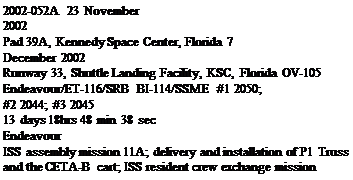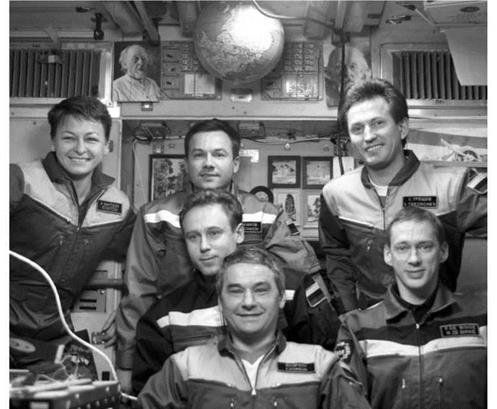. SOYUZ TMA1
Flight Crew
ZALETIN, Sergei Viktorovich, 40, Russian Air Force, commander, 2nd mission Previous mission: Soyuz TM30 (2000)
De WINNE, Frank, 41, Belgian Air Force, flight engineer 1 LONCHAKOV, Yuri Valentinovich, 37, Russian Air Force, flight engineer 2, 2nd mission
Previous mission: STS-100 (2001)
Flight Log
The crew for TMA1 seemed to be finalised in July 2002, with Mir veteran Sergei Zaletin and ESA Belgian astronaut Frank De Winne being joined by N Sync pop singer Lance Bass as the third space flight participant. This was the latest in a long line of suggested “millionaire” fare-paying cosmonauts for the flight. However, by 20 August, no payment from sponsors was forthcoming and Bass was removed from the crew.
To fill the seat and return the crew to a full complement of three, back-up commander Yuri Lonchakov was reassigned at short notice to fly the mission, the inaugural flight of the new Soyuz TMA1 spacecraft. TMA (Transport, Modification, Anthropometric) featured changes to allow taller and smaller crew members to fly in it, which meant that many of the American astronauts that had previously been unsuitable for Soyuz or ISS missions could now be considered for TMA training, a timely factor that became very fortunate in the next few months. Internal systems and provisions for comfort would allow crew members between 1.5 and 1.9m tall, instead of the previous 1.64 and 1.82 m in the TM craft.
Soyuz TMA1 was the first new variant of Soyuz to fly without a prior unmanned flight, and it docked with ISS on 1 November. During the week aboard the station, the two Russian cosmonauts briefed the Russian ISS-5 crew members on the features of
|
The first TMA crew pose for a group photo with the ISS-5 resident crew. In foreground is ISS-5 commander Valeri Korzun, in middle row is TMA1 commander Sergei Zalyotin (left) and Belgian ESA astronaut Frank De Winne. In the back row l to r are ISS-5 FE Peggy Whitson, TMA1 FE Yuri Fonchakov and ISS-5 FE Sergei Treshev |
the new spacecraft, assisted them with their work in the Russian segment, and participated in a small Russian science programme. They also assisted their Belgian colleague with his work. De Winne, the Belgian astronaut, conducted an ESA programme under the codename of Odessa that comprised 23 experiments. The programme featured research in the fields of biology, human physiology, physical sciences and education. He also talked with six students from universities in Scotland, Italy and The Netherlands who were at the ESA Taxi Flight Operations Coordination Centre (TOCC) at ESTEC in The Netherlands.
The crew landed in the TM34 spacecraft, the final descent of that variant of vehicle. According to Zaletin, the landing itself was “a little hard” as the vehicle hit the ground and tumbled a few times before coming to a halt. It was the first Russian night landing in ten years. The new TMA1 spacecraft, now docked to the ISS, would provide a return capability for the ISS-5 crew in the event of an emergency. This
capability was passed over to the ISS-6 crew in December, though they had not expected to use it.
Milestones
235th manned space flight 94th Russian manned space flight 87th manned Soyuz mission 1st manned Soyuz TMA mission 5th ISS Soyuz mission (5S)
4th ISS Taxi flight 4th ISS visiting mission
1st manned flight of (R7) Soyuz FG launch vehicle

 |
Flight Crew
WETHERBEE, James Donald, 49, USN, commander, 6th mission Previous missions: STS-32 (1990); STS-52 (1992); STS-63 (1995); STS-86 (1997); STS-102 (2001)
LOCKHART, Paul Scott, 46, USAF, pilot, 2nd mission Previous mission: STS-111 (2002)
LOPEZ-ALEGRIA, Michael Eladio, 44, USN, mission specialist 1, 3rd mission Previous missions: STS-73 (1995); STS-92 (2000)
HERRINGTON, John Bennett, 44, USN, mission specialist 2
ISS-6 crew up only:
BOWERSOX, Kenneth Duane, 45, USN, mission specialist 3, ISS-6 commander, 5th mission
Previous missions: STS-50 (1990); STS-61 (1993); STS-73 (1995); STS-82 (1997) BUDARIN, Nikolai Mikhailovich, 49, civilian, Russian mission specialist 4, ISS-6 flight engineer and Soyuz commander, 3rd mission Previous missions: Mir EO-19/STS-71 (1995); Soyuz TM27 (1998)
PETTIT, Donald Roy, 47, civilian, mission specialist 5, US ISS-6 science officer
ISS-5 crew down only:
TRESCHEV, Sergei Vladimiriovich, 43, civilian, Russian ISS-5 flight engineer, mission specialist 3
KORZUN, Valery Nikolayevich, 49, Russian Air Force, ISS-5 and Soyuz commander, mission specialist 4, 2nd mission Previous mission: Soyuz TM24 (1996)
WHITSON, Peggy Annette, 42, civilian, ISS-5 science officer, mission specialist 5
|
John Herrington (left) and Michael Lopez-Alegria work on the newly installed Port One (PI) Truss on ISS. Herrington is holding handrails attached to the CETA-B (2) cart |
Flight Log
Higher than allowed oxygen levels detected in the orbiter’s mid-body postponed the 11 November launch attempt, which was reset for 18 November. Technicians found a fatigued flexible hose to be the cause and this was replaced, but during the repair a platform impacted the RMS in the payload bay. The necessary inspections delayed the launch to 22 November. Bad weather at the TAL sites forced a further 24-hour delay in launch before the mission finally got off the ground. Docking with the station was achieved during FD 3 (25 November) and the following day, the P1 Truss was relocated to the port end of the SO Truss and automatically bolted in place. Unbeknown at the time, this would be the last time a Shuttle docked to the station for over 3O months.
The three EVAs on this mission were conducted in support of the truss installation, as well as for a number of other tasks. EVA 1 (26 Nov for 6 hours 45 minutes) saw Lopez-Alegria (EV1) and Herrington (EV2) complete the electrical, power and fluid connections to the P1 Truss and install the SPD, ensuring that the quick disconnection mechanisms were functioning correctly. They also released launch locks on the CETA-B cart and installed the Node Wireless video system External Transceiver Assembly (WETA) antenna. This would give reception for the EVA helmet cameras without the presence of a Shuttle. The second EVA (on Thanksgiving Day, 28 Nov, for 6 hours 10 minutes) saw the crew continue the electrical and plumbing connections and the installation of a second WETA on P1. The CETA-B (or 2) cart was also installed on the S1 Truss and secured to the CETA-A (or 1) cart. The third EVA (30 Nov for 7 hours) saw the completion of the SPD installation and troubleshooting of the stalled MT. The astronauts also freed and deployed a UHF antenna that had become snagged during relocation work.
During the flight, the ISS-5 crew handed over the command of the station to the ISS-6 crew and together, both resident crews worked to repair faulty hardware and install new equipment in the station. STS-113 had delivered over 1,969 kg of hardware and supplies to ISS, including new science experiments. The Shuttle’s engines were used in a series of burns to raise the orbit of the station. The formal hand-over of resident crews occurred shortly after the docking and the completion of safety briefings. Though no one knew it at the time, this would be the last Shuttle-based resident crew exchange for some time. Following undocking on 2 December, the Shuttle encountered four days of landing attempts being waived off due to bad weather, before finally making it on 7 December. This was the first time a mission had received three consecutive days of landing cancellations. This was also the last successfully completed Shuttle mission (launch to landing) for over two-and-a-half years.
Milestones
236th manned space flight
142nd US manned space flight
112th Shuttle mission
19th flight of Endeavour
56th US and 89th flight with EVA operations
16th Shuttle ISS mission
6th Endeavour ISS mission
5th Shuttle ISS resident crew exchange mission
1st native American (Chickasaw nation) to fly and walk in space (Herrington)












